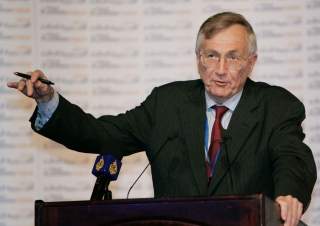Sy Hersh is Calling!
Seymour Hersh, in his Buddy Holly eyeglasses, unmemorable suit and rumpled raincoat—a cross between Woody Allen and Columbo—was enough to set hardened bureaucratic lifers atremble.
That’s not true—or at least it hasn’t always been true. In a May 1992 telephone call with Len Colodny, coauthor of the 1991 bestseller Silent Coup: The Removal of a President, a starkly revisionist account that challenged Woodward’s Watergate-era reportage, Hersh was caught on tape disparaging his fellow reporter. “I’ll tell you right now I had a conversation with
Woodward about you,” Hersh tells Colodny, according to a transcript I obtained. “Sy,” Colodny interrupts, “I’m gonna tell you this one last time: Bob Woodward is a[n] incredible liar.” “I know,” Hersh responds. “It hurts me to believe that he’s in my f***ing profession.”
NOT LONG after the September 11 attacks, while working on my own revisionist history of Watergate, I reached out to Hersh to get his advice and perhaps some cherished anecdotes from the era. The man I encountered telephonically on that occasion—and in a subsequent run-in, years later, on an elevator at a party thrown by The New Yorker—was very much the character recalled by all students of Hersh, fans and detractors alike, and his biographer, Robert Miraldi, a professor at the State University of New York. With Seymour Hersh: Scoop Artist (2013), Hersh did not cooperate; indeed, he even vetoed his sister’s agreement to speak with Miraldi:
He had long been intensely private and media shy, except when promoting a book or exposé…Writers have been chasing him for four decades. His home and work phone numbers are publicly listed, and he answers his own phone, abruptly, with “Hersh.” He will answer a few questions and then dismiss the caller with, “You’ve got enough. G’bye.”…Marianne Szegedy-Maszak tried to write about him in 1991 for Esquire, but he kept saying to her, “But imnotgonnatell you a thing.”
In my case the conversation was extended a bit because I was able to tell Hersh, truthfully, that I was calling him from the White House, which I was then covering for Fox News. “Who do they got doing the briefings over there nowadays?” he wanted to know. I thought it an odd request; in the immediate aftermath of 9/11, the press briefings by senior Bush-Cheney administration officials were routinely televised, in full. “Ari Fleischer is the press secretary,” I said haltingly. This triggered Hersh’s famous impatience. C’mon c’mon c’mon c’mon c’mon c’mon c’mon, he said—maybe ten c’mons in a space of two seconds, a classic display of the cantankerous big-city kibitzing I had grown up with in New York.
“You mean the background briefings?” Yeah yeah yeah, he said. Now I volunteered the name of a prominent female official who frequently briefed reporters on background. This prompted, from Hersh, a vulgar intimation unsuited for publication in the intellectual journal you hold in your hands. When I brought us back to John Mitchell, Hersh begged off. “Watergate was a long time ago, kid, and there’s a war going on now. That’s what I’m working on. Call me in a few months and maybe we can get together.” Click.
As Miraldi notes, the subjects of Sy Hersh’s nonfiction form a large contingent of enemies, people still furious at him decades after publication, “still convinced they were wronged.” Foremost among them is Kissinger, who turned ninety-five shortly before Reporter appeared in print. The former secretary of state occupies his own chapter in these pages, perhaps predictably, as he always occupied a special place in Hersh’s imagination and canon. The Price of Power: Kissinger in the Nixon White House (1983) is a deeply reported and thoroughly tendentious portrait. Hersh’s contempt for what he deems “the essential evil of the Nixon/Kissinger foreign policy” is matched only by his conviction that former Vice President Dick Cheney—the subject of a forthcoming magnum opus on which Hersh has been working for over a decade—was a “menace to civilization.”
Few readers will have the institutional knowledge, the archival reach, to adjudicate all the controversies Hersh has eagerly stoked; publication of his memoir will prove invaluable to his next biographer. Yet even those dubious about Hersh’s animadversions can welcome the arrival of this book. Hersh transports us back to another time, when shoe-leather reporting and documentary evidence mattered more than encrypted passwords and unique clicks, when editors and publishers still subsidized investigative reporting for months at a time, and reporters could pursue complex stories, as Hersh writes, “without having to constantly relay what was being learned on the newspaper’s web page.” Hersh notes that investigative sleuthing became harder after 9/11, but without identifying exactly why: the conquest of technology, which has made virtually all phone calls traceable.
In today’s crowded journalistic environment, no one reporter stands out the way Hersh once did. It is difficult to imagine the deputy attorney general of the United States and the CIA director indulging in a discussion about a working journalist in the Obama-to-Trump era that would resemble the exchange that occurred between Larry Silberman and William Colby on December 21, 1974, on the eve of the Times’ publication of Hersh’s expose on domestic spying. “The sob has sources that are absolutely beyond comparison,” Silberman marvels, in a transcript declassified decades later and published in Reporter. “He knows more about this place,” Colby said of the CIA, “than I do.”
James Rosen is a former chief Washington correspondent for Fox News and the author of three books, including The Strong Man: John Mitchell and the Secrets of Watergate (2008) and Cheney One on One (2015).

